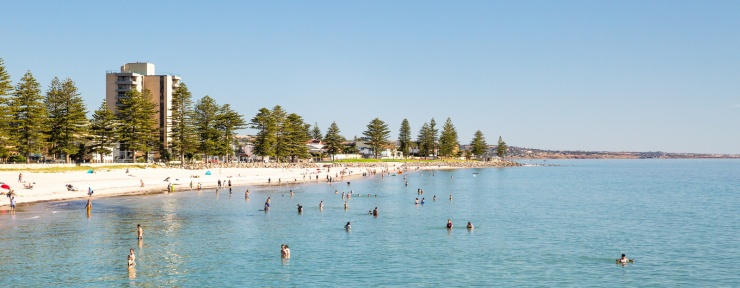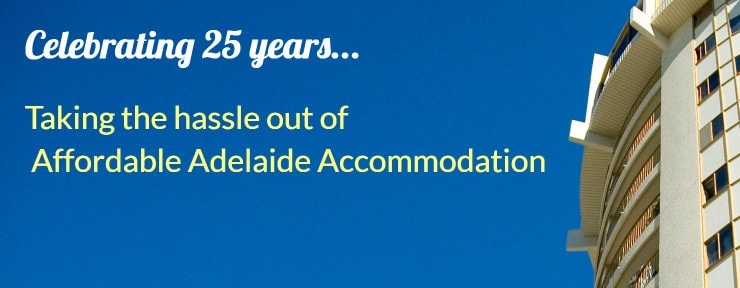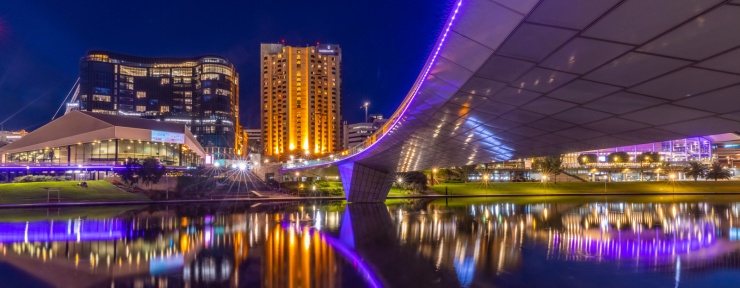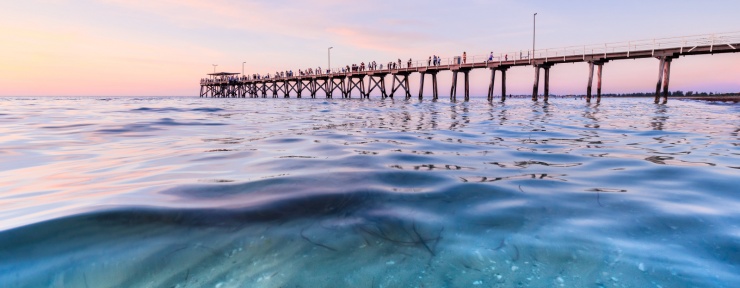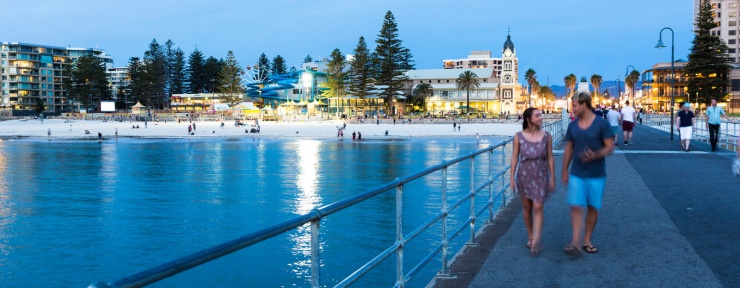➔ Book Now - Best Rates Guaranteed!
The History Behind the Atlantic Tower
Posted by Craig Leverenz on 19 May 2021 | Tags: History, Glenelg, Background
A lot of people often ask me about the history of the Atlantic Tower and Glenelg, so I thought I would share some of that history with you.
The Atlantic Tower
Construction began on the Atlantic Tower in 1971. The building was one of a proposed series of cylindrical towers running from Anzac Highway through to Jetty Road. The Atlantic Tower was actually the smallest of the four proposed cylindrical towers. The other towers were proposed at 16 levels, 18 levels and 24 levels. It was intended that each building in the complex would have a helipad on its roof, with the complex having a private fleet of helicopters to fly its occupants to work in the morning and back in the evening.
Mid way through construction, the developer went broke, leaving the Atlantic Tower as an empty shell for 8 years. During that time there were a few proposals for what to do with the building including turning it into a casino. The fourteen story tower was eventually bought by a local developer and was finally completed in 1980. It was Adelaide's tallest residential building for over 20 years and is still the tallest building in South Australia, outside of the Adelaide CBD.
The motel began trading in 1980 and was originally known as the 'Adelaide Atlantic Motel'. In 1992 the motel had a change in management and the name was changed to 'Atlantic Tower Motor Inn'.
In 2008 the Atlantic Tower Motor Inn began a massive refurbishment which has so far seen the complex increase it’s capacity to 36 rooms, of which, 20 rooms on the 9th to 11th floor have been fully refurbished including 4 new Premium Spa Rooms. The remaining 16 rooms are scheduled to be refurbished by the end of 2012.
Other high-rise development
Many other high-rise buildings exist in Glenelg, including the fifteen-story Stamford Grand hotel on Moseley Square, built in 1990.
The recent Holdfast Shores development, starting in the late 1990s, included the construction of the Marina Pier apartment building with its own private marina in Glenelg North and the Pier Hotel. The development was met with strong opposition, from both local residents and the City of Holdfast Bay, fearing over-development would ruin the area. Parts of the plan were scaled back, with the apartment building scaled down from fifteen stories to nine, and the cinema complex cancelled.
With the success of the Marina Pier, developers were quick to draw up plans for two other high rise buildings on the foreshore; another apartment complex and a hotel. Again these developments were met with strong opposition and the apartment building idea was abandoned. The original hotel proposed was to be called 'The Promenade', and it was planned to have been a 6-level $50 million, 5 star hotel. It was to have 180 rooms, a 2-level ballroom, function room, gaming room, swimming pool, gymnasium and a 213 space carpark. The plans were delayed however, resulting in the original plans being scrapped and the current Pier Hotel emerging. The current Pier Hotel is one level taller and contains 216 apartments (as opposed to hotel rooms). The name 'Pier Hotel' is in homage to the original Pier Hotel, which was demolished in 1988 to make way for the Stamford.
Four other high rise buildings were also originally planned for Colley Terrace at the time, including a 12 story, 300+ room hotel, a 12 story luxury apartment complex and two other 5 and 6 story apartment complexes. The 5 story apartment building went ahead but the local council blocked the plans for the other buildings. The developers were forced to come up with a universal solution, as opposed to 2-3 individual buildings and that solution was the Liberty Towers apartment complex, which was completed in 2004.
Glenelg history
Glenelg is a popular beach-side suburb of the South Australian capital of Adelaide. Located on the shore of Holdfast Bay in Gulf St Vincent, it has become a popular tourist destination due to its beach and many attractions, home to several hotels and dozens of restaurants.
Established in 1836, it is the oldest European settlement on mainland South Australia (the oldest being Kingscote on Kangaroo Island), with the proclamation of the colony of South Australia. It was named after Lord Glenelg, a member of British Cabinet and Secretary of State for War and the Colonies.
Through Lord Glenelg, the name derives from Glenelg, Highland (previously Inverness-shire), Scotland. In Scottish Gaelic the name is Gleann Eilg. The name Glenelg is noteworthy for being a palindrome.
Prior to the 1836 European settlement of South Australia, Glenelg and the rest of the Adelaide Plains was home to the Kaurna group of Indigenous Australians. They knew the area as "Pattawilya" and the local river as "Pattawilyangga", now named the Patawalonga River.
Settlement
The first British settlers set sail for South Australia in 1836. Several locations for the settlement were considered, such as Kangaroo Island, Port Lincoln and Encounter Bay. The Adelaide plains were chosen by Colonel William Light, and Governor John Hindmarsh proclaimed the province of South Australia at the site of The Old Gum Tree in Glenelg North on 28 December 1836.
The first post office in Glenelg opened on 5 December 1849; the first postmaster was John McDonald of the St Leonard's Inn. A telegraph office was opened in September 1859 and the two offices amalgamated in 1868. The post office building on Moseley Square was built in 1912 and was used until 2010 when the post office moved into the new Bay Junction shopping complex.
Construction of the Glenelg Institute, which is now the Glenelg Town Hall started in 1875. The institute opened in 1877, with lecture rooms, a concert hall and a library. The classical structure was designed by Edmund Wright, whose works include the Adelaide Town Hall and Adelaide General Post Office on King William Street. The hall sits on Moseley Square, just off the beach. The city council acquired the hall in 1887. Today it houses restaurants and the Bay Discovery Centre, a free museum about Glenelg’s history.
Jetty
In August 1857, construction of Glenelg's first jetty commenced; it was opened on 25 April 1859. Costing over £31,000 (pounds sterling) to build, the structure was 381 metres (1,250 ft) long. The jetty was used not only by fishermen but also to accept cargo from ships, including a mail service operated by P&O, until Port Adelaide replaced it as Adelaide's main port.
There were several additions to the jetty. A lighthouse was built in 1872 at the jetty's end, but a year later it caught fire and was cast into the sea to save the rest of the structure. A replacement lighthouse was built in 1874, and was 12.1 metres (40 ft) tall. Other additions include public baths, an aquarium, a police shed and a three-story kiosk with tea rooms. The kiosk structure also housed a family.
The kiosk was wrecked in a storm in 1943, and the entire jetty was destroyed by a freak hurricane in 1948, most of the structure washed away and the rest unsafe. Just two weeks later, local council began drafting plans for a new jetty and construction was completed in 1969. The new structure was just 215 metres (705 ft) long, less than two thirds of the original jetty. The second jetty continues to stand today, at the end of Jetty Road.
Amusement
Glenelg has been a popular spot for recreation and leisure for much of its history. Following the success of Luna Park, Melbourne, a similar amusement park was constructed on Glenelg's foreshore in 1930. Luna Park Glenelg was placed in voluntary liquidation in 1934, and all the rides (excluding a single carousel) were disassembled, purchased by the directors, and transported to Sydney, where they were used to create Luna Park Milsons Point. The park's managers claimed that the reasons for the closure were the inability to make money from the park as it was, and opposition to changes from Council and residents, who were afraid that "undesirables" would be attracted to the area.
Built near the former Luna Park site was Magic Mountain, which first opened in 1982. It featured water slides, mini-golf, bumper boats, dodgem cars and many other amusements and was popular with many Adelaide residents. It was also extensively criticised and called an eyesore; despite this it was heavily popular with young children and teenagers.
As part of the Holdfast Shores development, Magic Mountain was finally demolished in 2004 and replaced with The Beachouse, a modern centre with a more conservative design which still incorporates the historic carousel; it opened in mid 2006. A 25-metre single-arm Ferris wheel is a popular amusement during school holidays and is a prominent feature of the area.
Wallis Cinemas opened South Australia's first multi-screen cinema in 1971 when the single-screen Glenelg Ozone was purchased and transformed into the Glenelg Cinema Centre. The Glenelg cinema centre was a very popular attraction until Greater Union Megaplex Marion (now Event Cinemas) opened in 1997 with 30 screens. From that point onwards the Glenelg Cinema Centre’s patronage continued to decline until it finally had to close it’s doors in February 2009. Local residents fought to keep the building, hoping that a new owner could be found. Protests were held and a Facebook page was created with over 2500 members in a bid to save the complex. In the end developers won the battle and in 2011 the building was demolished to make way for another shopping complex.
Transport
The suburb is bordered by Anzac Highway, the road link to the Adelaide CBD. Jetty Road is the main shopping strip in the suburb, and runs down the middle. The Adelaide Metro operates several bus services from Glenelg to various destinations including the City of Adelaide and Adelaide Airport. The local council operates a free loop bus service in the area.
The only tram line still operating in Adelaide is the Glenelg Tram, which runs from Moseley Square, along Jetty Road though Glenelg, to the Adelaide CBD and Entertainment Centre. The route dates back to 1873 and is occasionally still operated on weekends and holidays by the historic H-Class trams, circa 1929. Weekday service was taken over by modern Bombardier Flexity Classic trams in 2006.
Recreational boating is popular in Glenelg. To the north is the mouth of the Patawalonga River, which has been dammed to create an artificial boat harbour with a lock down to the sea.
Events and attractions
- Jetty Road is a long ribbon of shops, entertainment facilities and other commercial activities - it is the main shopping precinct in Glenelg.
- There are well over 50 restaurants, cafe's and bars in Glenelg.
- Glenelg is home to Temptation Sailing, a unique charter boat which runs a daily 'Swimming with the dolphins' experience.
- Glenelg is also the home of the Bay Discovery Centre, a free museum about Glenelg's history.
- On the foreshore of Glenelg is The Beachouse, a massive entertainment complex with waterslides, rides and games.
- Glenelg is the finishing point of the annual City-Bay fun run held in September. The run is 12 km long.
- Glenelg is home to a team in the South Australian National Football League (SANFL), the Glenelg Tigers.
- The annual Bay Sheffield race is held at Glenelg in December.

